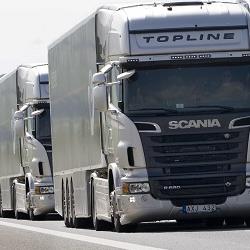The European Automobile Manufacturers Association (ACEA) has recently joined more 10,000 experts to explore the potential of Intelligent Transport Systems (ITS) technology. From the perspective of Europe’s heavy-duty vehicle manufacturers, developments in the field of truck platooning are among the most promising ITS innovations.
 Platooning – which is the linking of two or three self-driving trucks in convoy – can optimise transport by using roads more effectively, delivering goods faster through fewer traffic jams. Even more importantly, platooning has the potential to improve road safety, make transport more fuel efficient, and thus significantly reduce CO2 emissions from heavy-duty vehicles. Manufacturers are eager to bring this technology to Europe’s roads and the first real-life tests are underway. However, differences in legislation between EU Member States means that it will be some more years before we can see these convoys on the road.
Platooning – which is the linking of two or three self-driving trucks in convoy – can optimise transport by using roads more effectively, delivering goods faster through fewer traffic jams. Even more importantly, platooning has the potential to improve road safety, make transport more fuel efficient, and thus significantly reduce CO2 emissions from heavy-duty vehicles. Manufacturers are eager to bring this technology to Europe’s roads and the first real-life tests are underway. However, differences in legislation between EU Member States means that it will be some more years before we can see these convoys on the road.
To take advantage of the potential of self-driving trucks, it is important to harmonise all relevant national regulations. French law, for example, defines a safe driving distance between trucks as 50 metres, while Germany uses a different unit of measurement as it enforces a driving time of two seconds. To accelerate the introduction of automated trucks in Europe, the Netherlands – which will take over the EU Presidency from Luxembourg on 1 January – is organising the European Truck Platooning Challenge in order to put the subject high on the agenda of EU policy makers in 2016. This pilot project will bring various self-driving trucks on the road with a mission to cross European borders in convoy.
ACEA and its commercial vehicle members are actively supporting and participating in the European Truck Platooning Challenge in order to make self-driving trucks a common sight in the near future. Platooning will not only help the European truck industry to strengthen its technical leadership and global competitiveness, but also is expected to make a significant contribution to reducing CO2 emissions from road transport. Studies estimate that truck platooning can reduce fuel consumption, and with that CO2 emissions, by up to 5%.
Even though Europe’s truck manufacturers have reduced CO2 emissions from their vehicles by 60% over the last decade, ACEA members believe that more can be done by looking beyond vehicle technology alone. That is why truck platooning is part of the industry’s comprehensive approach to further reducing CO2 emissions. This holistic approach not only focusses on new vehicles, but instead looks at all elements that affect emissions during the use of a truck. Besides the vehicle itself, trailer design, alternative fuels, logistics, infrastructure and ITS technology (such as platooning) all play a decisive role in further reducing fuel consumption, and thus CO2 emissions, in years to come.
The aerodynamic benefits of platooning
According to Scania, if the second truck is 25 metres behind, its drag is reduced by 30 per cent and the third truck in line will benefit from a 40 per cent drag reduction. The leading truck will also take advantage of platooning by reduced adverse rear aerodynamic effects as the tailing vehicle ‘pushes’ the truck ahead forward.
Click here to see the next Editor's Pick